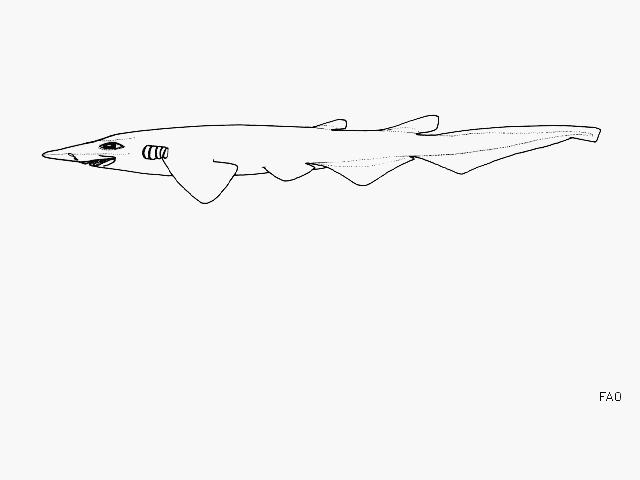Apristurus riveri
Bigelow & Schroeder, 1944
Broadgill catshark
Classification: Elasmobranchii Carcharhiniformes Pentanchidae
Reference of the original description
New sharks from the Western North Atlantic. Proceedings of the New England Zoölogical Club, 23, 21–36
New sharks from the Western North Atlantic. Proceedings of the New England Zoölogical Club, 23, 21–36
Image of the original description
Image in copyright.
Image in copyright.
Description :
Citation: Apristurus riveri Bigelow & Schroeder, 1944: In: Database of modern sharks, rays and chimaeras, www.shark-references.com, World Wide Web electronic publication, Version 01/2026
Please send your images of "Apristurus riveri" to info@shark-references.com

Apristurus riveri Bigelow & Schroeder, 1944, © FAO, www.fish-base.org

Apristurus riveri Bigelow & Schroeder, 1944, © FAO, www.fish-base.org
Common names
 Gatica afilada,
Gatica afilada,  Pajegato agallón,
Pajegato agallón,  Holbiche grandes oreilles,
Holbiche grandes oreilles,  Broadgill Catshark,
Broadgill Catshark,  Broadgill cat shark
Broadgill cat shark
 Gatica afilada,
Gatica afilada,  Pajegato agallón,
Pajegato agallón,  Holbiche grandes oreilles,
Holbiche grandes oreilles,  Broadgill Catshark,
Broadgill Catshark,  Broadgill cat shark
Broadgill cat shark
Short Description
Relatively slender, moderately long, narrow snout and relatively narrow, low caudal fin. Color uniform dark brown (Ref. 37039). First to third gill openings long as the distance between the nostrils (Ref. 6032).
Relatively slender, moderately long, narrow snout and relatively narrow, low caudal fin. Color uniform dark brown (Ref. 37039). First to third gill openings long as the distance between the nostrils (Ref. 6032).
Distribution
Western Central Atlantic: Cuba, northern Gulf of Mexico, and Panama. Source: www.gbif.org
Western Central Atlantic: Cuba, northern Gulf of Mexico, and Panama. Source: www.gbif.org
Human uses
fisheries: of no interest
fisheries: of no interest
Biology
Oviparous, paired eggs are laid. Embryos feed solely on yolk [733]. Sexual dimorphism is evident in dentition of males (Ref. 49562). Males have longer teeth with fewer cusps (Ref. 51093) to make "quot;courtship biting"quot; more effective (Ref. 49562).
Oviparous, paired eggs are laid. Embryos feed solely on yolk [733]. Sexual dimorphism is evident in dentition of males (Ref. 49562). Males have longer teeth with fewer cusps (Ref. 51093) to make "quot;courtship biting"quot; more effective (Ref. 49562).
Remarks
shark-references Species-ID=341;
shark-references Species-ID=341;
















